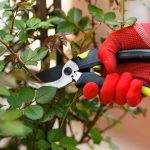If your lawn looks like it’s drowning in winter weeds, it may be a good time to start mowing, cutting or weeding.
Thanks to moderate weather and recent rains, cool season annual seedlings are germinating like gangbusters in Texas lawns and gardens and are ready to bolt! Whether they’re wildflowers or winter weeds, all will soon send their flower stalks skyward to disperse seeds for the next year’s crop.
If you’re growing wildflowers intentionally, all you have to do is wait and see if that seedling is a wildflower you want, or a weed that needs to go. But for those who prefer a uniform lawn (regardless if it’s a Texas bluebonnet or an invasive sow thistle) here are a few good tips to tidy up your landscape in winter:
- Stop watering in November. Last year’s weed seeds start to germinate in the fall and they keep growing despite winter freezes. The less supplemental water you put on your lawn, the fewer winter weeds you’ll have to deal with (and the lower your SAWS bill will be).
- Cut it. Frequent mowing will result in less seeds next year. Many winter weeds are annuals and if they don’t produce seeds, they won’t come back next year. A string trimmer is effective at knocking down the weeds as needed, especially in large lots.
- Mechanical removal. Good ol’ hand-pulling is both satisfying and absolute. There’s nothing better than yanking up a huge hedge parsley (with a taproot the size of an overgrown carrot). With hand-pulling, you have completely killed the plant and can rest assured it won’t reproduce. For smaller properties, this method is ideal.
A garden hoe or stirrup hoe can achieve the same effect, but they work best in garden beds when the plants are younger. - Consider corn. Corn gluten meal, to be precise, is a protein found in corn. It’s a digestible co-product of corn processing, has been used as a food flavoring in livestock and pet foods — and it functions as a pre-emergent when used as an herbicide. This means it prevents seedlings from developing in the first place (so if you’ve overseeded your lawn with grass seed, corn gluten is not recommended). Corn gluten also fertilizes grass in the form of nitrogen. It’s a bona-fide natural “weed and feed!” But be aware: because of its high nitrogen content, it should not be used where it can run off directly into a watershed because excess nitrogen is a pollutant in our creeks and rivers.
Manufacturers bind the meal into a soluble pellet form so that it can be applied in a fertilizer spreader. The application rate is heavy (about 20 pounds per 1,000 square feet) but the cost is generally lower than other fertilizers and herbicides. As a preemergent, timing is important. For next summer’s warm weather weeds you can start applying it in February, and again in September for next year’s winter weeds.
With all these methods, perseverance and patience will pay off. Of course, there is already seed bank in your soil — so no matter how many weeds you remove this year, there will probably be some popping up next year. The idea is to keep decreasing the amount each successive year until there are none left.
So, if your lawn looks like it’s drowning in winter weeds, it may be a good time to start mowing, cutting or weeding! And next fall, turn off your irrigation system and keep mowing through the winter.




